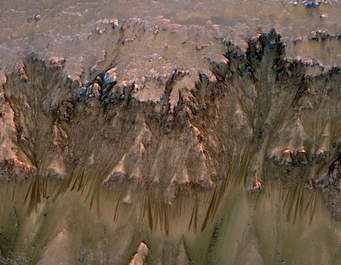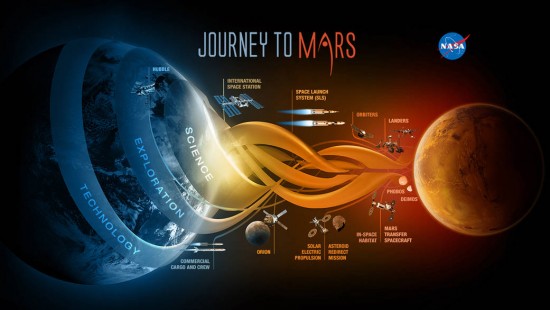October 5, 2015 – All the boxes have been unpacked. All the cupboards are stuffed to the gills. Finally I can begin to get back to what I like doing, writing about science, technology and the future. Today it is the juxtaposition of the new movie, The Martian, and several recent announcements from NASA that inspires this posting.
In anticipation of this latest space movie I downloaded Andy Weir‘s compelling novel, The Martian, upon which the film is based, describing a stranded astronaut’s ordeal on the surface of Mars. Weir’s book first self-published in 2011 has become a global bestseller. It describes how a very smart and tenacious American astronaut named Mark Watney uses his own ingenuity and NASA tools and technology designed for human missions to Mars to stay alive when stranded on the Martian surface. Starring Matt Damon as Watney, this tale of woe is believable because Weir stays true to the science and technology that exists or is in the planning stages for future off world missions.
Watney is left for dead by the rest of his crew when a dust storm forces an emergency evacuation of a future NASA Mars mission landing site. With him separated from the rest of the crew and the telemetry from his spacesuit malfunctioning the unconscious Watney gets left behind. But he survives the storm to find himself alone. With a will to survive he displays incredible inventiveness. He turns left over hydrazine fuel into freshwater. He takes potatoes brought along during the mission and plants them inside the Martian habitat that was designed to support the mission crew for a month-long stay. He uses the human transportation systems abandoned by the crew to explore his immediate surroundings and to haul materials back to the habitat. He cobbles together solar panels and battery storage to extend the range of his transport systems with a goal to reach the next human mission landing site to await rescue.
One NASA staffer monitoring images satellite images from Mars notes his activities and alerts alerts the organization to the fact that Watney is very much alive.A bold rescue plan unfolds. But until it can happen Watney has to stay alive modifying technology at hand to help achieve that goal.
The story is a riveting read. If you haven’t had a chance to get a copy or have yet to see the movie I have no intention of being a spoiler. I recommend you download the book, buy it, or get it from your local library, and of course, considering the movie reviews that came out last week, I think a visit to your local theatre may be in order in the near future.
NASA couldn’t help but get into the action with the movie release. The agency is helping to promote the new film as a way of publicizing its own plans to mount missions to Mars in the fourth decade of the 21st century. The next rover mission will include an instrument for harvesting oxygen from carbon dioxide in the Martian atmosphere. The technology is featured in The Martian.
The Space Launch System (SLS) will be undergoing its first proving ground missions before the end of this decade. NASA is also developing the self-sustaining life support systems including the testing of human endurance in space in a current year-long mission on the International Space Station (ISS). Even farming in space is being developed on board ISS so growing potatoes on Mars is far from being far fetched.To get human-sized payloads and habitations that humans can live in on Mars, NASA is testing new heat shield inflatable decelerators, rocket systems capable of soft landing, and parachute systems designed to protect payloads during descent to the planet surface. And between now and the mid-2030s NASA plans for additional orbiters and rovers to accompany its existing robots – Opportunity, Curiosity, Mars Odyssey, Mars Reconnaissance Orbiter and MAVEN, to further explore the Martian surface and study it from orbit with specific goals to test support technologies, discover Martian resources of use to future missions, and select human landing sites.
Speaking of the Mars Reconnaissance Orbiter (MRO) and what its on board instruments have detected we now know from published findings in the last week that Mars today has surface water that flows in the relative warmth of its summer every year. MRO and other orbiters have taken pictures like the one seen below that show surface changes in the form of streaks on down slopes (see lower part of the picture). These dark stains appear when surface temperatures rise to minus 23 Celsius (minus 10 Fahrenheit) degrees or warmer. Analysis indicates that the stains are subsurface water on the move with enough of it reaching the surface to cause a color change. The water is salty which is why it can be in liquid state even with temperatures well below freezing.
The timing of the information release is, in my opinion, no coincidence. We have known since the Phoenix Lander reached Mars that there was water in Martian soil. When Phoenix first scraped the soil of Mars uncovering a white substance beneath, analysis showed that this was ice. Over days the exposed ice eventually evaporated. Analysis by Phoenix showed that this was briny water containing perchlorate. We also have known from Earth-based observations that Mars contains a legacy of frozen water in its polar ice caps. And orbiters have provided us with tantalizing evidence of glacier-sized deposits of ice under Mars’ surface. But the mystery of the seasonal streaks on Martian canyon slopes was not fully explained until now.
So it seems a confluence of events and discoveries is driving the agenda to get humans to the Red Planet in this century despite the many challenges. I for one think that we need to establish permanent human habitation in space before we decide to people Mars but this seems to be ignored by space agencies like NASA when looking at the next steps in our outward urge. Proving we can create self-sustaining communities in space, building artificial gravity systems that ensure our bodies adapt, finding technologies to deal with the threat posed by cosmic radiation and solar flares – all these challenges must be met before we consider setting foot on another planetary orb in this Solar System. It seems the cart is being placed before the horse in this drive to get to Mars.









